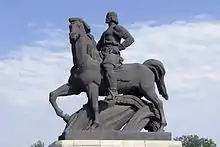Dobrotitsa
Dobrotitsa (Bulgarian: Добротица, pronounced [doˈbrɔtit͡sɐ]; Romanian: Dobrotici or Dobrotiţă; Τομπροτίτζας in contemporaneous Byzantine documents;[1] Dobrodicie in contemporaneous Genoese documents[2]) was a Bulgarian noble, ruler of the de facto independent Principality of Karvuna and the Kaliakra fortress from 1354 to 1379–1386.[3][4][5]
Dobrotitsa | |
|---|---|
 Monument to Dobrotitsa in Dobrich (Bulgaria). | |
| Despot of Dobruja | |
| Reign | 1347 - 1386 |
| Predecessor | Balik |
| Successor | Ivanko |
| Born | 14th century |
| Died | 1386 |
| Issue | |
Dobrotitsa's ethnic origin is disputed, in consequence he is considered by some a Bulgarian[6] noble kindred of the Terter dynasty (from the Cuman Terteroba clan),[7][8] to others a Vlach (mostly by Romanian historians),[9] and to others a Christianized Turk.[10] Venetian sources from the late 14th century refer to Dobrotitsa as a "despot of Bulgarians" (DESPOTUM BULGARORUM DOBROTICAM) and to his realm as "parts of Zagore (Bulgaria) subordinate to Dobrotitsa" (PARTES ZAGORAE SUBDITAS DOBROTICAE).[11]
In 1346, Dobrotitsa and his brother Theodore were sent along with 1,000 soldiers by the Dobrujan ruler Balik to help the Byzantine Empress Anna of Savoy in the civil war against John VI Kantakouzenos, but were defeated by George Phakrases. The following year, after the death of Balik, he became the ruler of Dobruja. In 1348 Dobrotitsa took over the fortress of Midia and by 1356 managed to seize Kozyak (present-day Obzor) and Emona from the Byzantines.[12]
In 1366 Emperor Ivan Alexander refused to allow the Byzantine emperor John V Palaiologos, who was returning home from Hungary, passage through Bulgaria. In order to force the Bulgarians, a relative of John V, Count Amadeus VI of Savoy, then leading his own the Savoyard crusade, attacked the Bulgarian coastal towns. In the fall of the same year Amadeo's navy captured Anchialos, Mesembria, Emona and on 25 October he besieged the strong fortress Varna, where he was repulsed. As a result, Ivan Alexander gave the Byzantines safe conduct across Bulgaria and they kept the conquered towns.[13] In 1369 Dobrotitsa and Vladislav I of Wallachia helped Ivan Alexander to defeat the Hungarians and retake Vidin.[14] Out of gratitude, the Emperor gave Dobrotitsa Emona and Kozyak.[15] Later he built a navy in Varna which was engaged in actions as far as Trebizond. The Genoese manuscripts write that his navy was very strong albeit rather small and achieved successes against the Ottomans and Genoese.[2] He was succeeded by his son Ivanko in 1386.
The names of the region of Dobruja derives from the Turkish rendition of his name.[16] The city of Dobrich and two villages in northern Bulgaria are also named after him.
References
- John Kantakouzenos, Historiarum, II, p584-585, ed. Bonn
- M. Balard, Actes de Kilia du notaire Antonio di Ponzo, 1360 in Genes et l'Outre-Mer, II, Paris, 1980 "Archived copy". Archived from the original on 2007-03-05. Retrieved 2007-01-31.CS1 maint: archived copy as title (link)
- The Late Medieval Balkans: A Critical Survey from the Late Twelfth Century to the Ottoman Conquest, John V. A. Fine, John Van Antwerp Fine, University of Michigan Press, 1994, ISBN 0472082604, p. 367.
- Cumans and Tatars: Oriental Military in the Pre-Ottoman Balkans, 1185-1365, István Vásáry, Cambridge University Press, 2005, p. 78.
- At Europe's Borders: Medieval Towns in the Romanian Principalities, Laurențiu Rădvan, BRILL, 2010, ISBN 9004180109,P. 508.
- Васил Н. Златарски, История на българската държава през средните векове, Част I, II изд., Наука и изкуство, София 1970.
- Г. Бакалов, История на българите, Том 1, 2003, с457
- Петър Николов, Сквирските князе Половци-Рожиновски — клон на династията Тертер, online, retrieved 03-24-2007
- Nicolae Iorga, Notes d’un historien relatives aux événements des Balcans in Bulletin de la Section Historique de l'Academie Roumaine, Bucharest, 1913
- Halil Inalcik, Dobrudja in Encyclopedia of Islam, II, Leiden, 1991
- Васил Гюзелев, ed. (2001). Венециански документи за историята на България и българите от XII–XV в. (in Bulgarian). София: Главно управление на архивите при Министерския съвет. pp. 108, p. 136. ISBN 954-08-0022-9.
- Ioannes Cantacuzenus Historiarum..., II, p384 sq
- Fine, Late Medieval Balkans, p. 367
- Георги Бакалов, История на България, "Есента, 1369 г."
- Гюзелев в. Средновековната крепост Калиакра, с.127
- Paul Wittek, Yazijioghlu 'Ali on the Christian Turks of the Dobruja in BSOAS, London, 1952
Sources
| Wikimedia Commons has media related to Dobrotitsa. |
- Васил Н. Златарски, История на българската държава през средните векове, Част I, II изд., Наука и изкуство, София 1970.